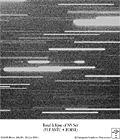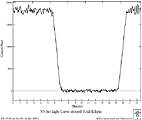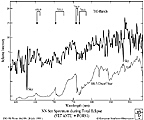Information from the European
Southern Observatory
ESO Press Release
11/99
20 July 1999
For immediate release |
|
A Vanishing Star
Revisited
VLT Observations of an
Unusual Stellar System
Reinhold Häfner of the Munich University Observatory
(Germany) is a happy astronomer.
In 1988, when he was working at a telescope at
the ESO La Silla observatory, he came across a
strange star that suddenly vanished off the
computer screen. He had to wait for more than a
decade to get the full explanation of this unusual
event.
On June 10-11, 1999, he observed the same star
with the first VLT 8.2-m Unit Telescope (ANTU) and
the FORS1 astronomical instrument at Paranal [1].
With the vast power of this new research facility,
he was now able to determine the physical
properties of a very strange stellar system in
which two planet-size stars orbit each other.
One is an exceedingly hot white
dwarf star , weighing half as much as the Sun,
but only twice as big as the Earth. The other is a
much cooler and less massive red
dwarf star , one-and-a-half times the size of
planet Jupiter.
Once every three hours, the hot star disappears
behind the other, as seen from the Earth. For a
few minutes, the brightness of the system drops by
a factor of more than 250 and it "vanishes" from
view in telescopes smaller than the VLT.
A variable star named NN
Serpentis
|

ESO PR Photo
30a/99
[Preview
- JPEG: 400 x 468 pix - 152k]
[Normal
- JPEG: 800 x 936 pix - 576k]
[High-Res
- JPEG: 2304 x 2695 pix - 4.4M] |
Caption to ESO PR Photo
30a/99 : The sky field around the 17-mag
variable stellar system NN Serpentis, as
seen in a 5 sec exposure through a V(isual)
filter with VLT ANTU and FORS1. It was obtained
just before the observation of an eclipse of
this unsual object and served to centre the
telescope on the corresponding sky position. The
field shown here measures 4.5 x 4.5
armin2 (1365 x 1365 pix2;
0.20 arcsec/pix). The field is somewhat larger
than that shown in Photo 30b/99 and has the same
orientation to allow comparison: North is about
20° anticlockwise from the top and East is 90°
clockwise from that direction.
|
The unsual star in question is designated NN Serpentis , or just NN Ser . As the name indicates, it
is located in the constellation of Serpens (The
Serpent), about 12° north of the celestial
equator. A double letter, here "NN", is used to
denote variable stars [2].
It is a rather faint object of magnitude 17, about
25,000 times fainter than what can be perceived
with the unaided eye. The distance is about 600
light-years (180 pc).
In July 1988, Reinhold Häfner performed
observations of NN Ser (at that
time still known by its earlier name PG
1550+131) with the Danish 1.54-m telescope at
La Silla. He was surprised, but also very pleased
to discover that it underwent a very deep eclipse every 187
minutes. Within less than 2 minutes, the
brightness dropped by a factor of more than 100 (5
magnitudes). During the next 9 minutes, the star
completely disappeared from view - it was too
faint to be observed with this telescope. It then
again reappeared and the entire event was over
after just 11 minutes.
Why eclipses are so
important for stellar studies
An eclipse occurs when one of the stars in a
binary stellar system moves in front of the other,
as seen by the observer. The effect is similar to
what happens during a solar eclipse when the Moon
moves in front of the Sun. In both cases, the
eclipse may be partial or total,
depending on whether or not the eclipsed star (or
the Sun) is completely hidden from view. The
occurence of eclipses in stellar systems, as seen
from the Earth, depends on the spatial orientation
of the orbital plane and the sizes of the two
stars. Two eclipses take place during one orbital
revolution, but they may not both be
observable.
The physical properties of the two stars in a
binary system (e.g., the sizes of the stars, the
size and shape of the orbit, the distribution of
the light on the surfaces of the stars, their
temperatures etc.) can be determined from the
measured "light-curve" of the system (a
plot of brightness vrs. time). The stars are
always too close to each other to be seen as
anything but a point of light. The light-curve
thus describes the way the total brightness of the
two stars changes during one orbital revolution,
including the variation of the combined light of
the two components as they cover each other during
the eclipses.
Already in 1988, it was concluded that the
eclipse observed in NN Ser must
be caused by a bright and hot star (a white
dwarf) being hidden by another body, most
probably a red dwarf star. Because of the
dramatic effect, this object soon became known as
the "Vanishing Star", cf. ESO Press Release
09/88 (8 December 1988).
Critical information missing
for NN Ser
One particularly critical piece of information
is needed for a light-curve study to succeed, that
is whether the eclipse is "total" or
"partial". If during the eclipse one star is
entirely hidden by the other, we only see the
light of the star in front. In that case, the
measured amount of light does not change during
the phase of totality. The light-curve is "flat"
at the bottom of the minimum and the measured
brightness indicates the intrinsic luminosity of
the eclipsing star. Moreover, for a given orbit,
the duration of the totality is proportional to
the size of that star.
This crucial information was not available for
NN Ser . The brightness at
minimum was simply too faint to allow any
measurements of the system with available
telescopes during this phase. For this reason, the
properties of the eclipsing star could only be
guessed.
Reaching for the bottom
The new VLT observations have overcome this.
Thanks to the powerful combination of the 8.2-m
ANTU telescope and the multi-mode FORS1
instrument, it was possible to measure the
complete lightcurve of NN Ser ,
also during the darkest phase of the eclipse.
This extreme observation demanded most careful
preparation. Since there is very little light
available, the longest possible integration time
must be used in order to collect a sufficient
number of photons and to achieve a reasonable
photometric accuracy. However, the eclipse only
lasts a few minutes and it would only be possible
to exposure and read-out a few, normal exposures
from the CCD camera, not enough to fully
characterize the light curve at minimum.
Reinhold Häfner decided to use another
method. By having the telescope perform a
controlled change of position on the sky ("drift")
during the exposure, the light from NN Ser before, during and after
the eclipse will not be registered on the same
spot of the camera detector, but rather along a
line. He carefully chose a direction in which this
line would not cross those of other stars in the
neighbourhood of NN Ser . This
was ensured by rotating FORS1 to a predetermined
position angle.
The drift rate was fixed as one pixel (0.20
arcsec) per 3 seconds of time, a compromise
between the necessary integration time and desired
time resolution that would give the best chance to
document the exact shape of the
light-curve. In theory, this would then allow
the measurement of the intensity along the
recorded trail of NN Ser and
hence its brightness at any given time during the
eclipse.
But how deep would the eclipse be? Would the
resulting exposure on each pixel at minimum light
be long enough to register a measurable
signal?
Seeing the light from the
cool star!
|

ESO PR Photo
30b/99
[Preview
- JPEG: 400 x 464 pix - 156k]
[Normal
- JPEG: 800 x 927 pix - 584k]
[High-Res
- JPEG: 2292 x 2662 pix - 4.1M] |

ESO PR Photo
30c/99
[Preview
- JPEG: 472 x 400 pix - 48k]
[Normal
- JPEG: 943 x 800 pix - 96k] |
|
Caption to ESO PR Photo
30b/99 : 18.5-min "drift" exposure with VLT
ANTU and FORS1 of the sky field around the
variable stellar system NN Ser (indicated
with an arrow). The telescope moved 1 pixel
(0.20 arcsec) every 3 seconds so that the images
of the stars in the field are trailed from left
to right. After some minutes, the very deep
eclipse of NN Ser begins when the
brightness drops dramatically during the
first partial phase. The star is
clearly visible at a constant level all
through the total phase at minimum light.
It then brightens during the second
partial phase and is back to the former
level after approximately 10.5 min. The FORS1
instrument was rotated by about 70° to ensure
that the trail of NN Ser would not
overlap those of the neighbouring stellar images
during this special exposure. The field shown
measures 2.7 x 2.7 armin2 and may be
compared with that shown in Photo 30a/99; it has
the same orientation.
Caption to ESO PR Photo
30c/99 : The light-curve of the
variable stellar system NN Ser, as
extracted from the drift exposure shown in Photo 30b/99 . The count rate is
proportional to the brightness of the object; it
is about 18,000 counts/pix outside the eclipse
and decreases to about 70 counts during the
total eclipse (since the full range of the
eclipse is shown here, this low level is almost
indistinguishable from 0 in this figure).
Various properties of the two stars in the NN
Ser system may be determined from the shape
of the light-curve. The fact that the
light-curve is "flat" at the bottom is a clear
sign that the eclipse is total, i.e. the
hot white dwarf star is completely hidden behind
the cool red dwarf star.
|
As ESO PR Photo 30b/99
shows, ANTU and FORS1 did manage this difficult
observation! Aided by an excellent seeing of 0.5
arcsec, i.e. a good concentration of the light on
each pixel, the recorded signal from NN Ser - although very faint - is
well measurable at all times during
the eclipse . In the mean, about 70
counts/pixel were registered at the minimum, down
from about 18,000 outside the eclipse (Photo 30c/99 ). The ratio is then
about 250, corresponding to just over 6
magnitudes. The measured magnitude during eclipse
is 23.0 in the V-band (green-yellow; wavelength
550 nm).
Of even greater importance is the fact that the
light-curve is found to be perfectly flat at the
bottom, i.e. the eclipse is most certainly
total. The white dwarf star is therefore
being completely hidden as it moves behind the
cooler and larger star, and we see only the latter
during the eclipse. As explained above, this then
allows to determine many of its properties. For
instance, the fact that the light-curve has no
obvious "soft shoulders" at the beginning and end
of the total phase indicates that the white dwarf
abruptly disappears from view. Thus the faint star
cannot have a very extended atmosphere, otherwise
the brightness change would have been more
gradual.
The total phase was found to last 7m
37s and each of the partial phases only
1m 26s. This shows that the
orbit must be nearly perpendicular to the plane of
the sky. This angle is referred to as the
orbital inclination; for NN
Ser , it must be in the interval between 84° -
90°.
A preliminary analysis indicates that the
diameter of the cool star is between 200,000 and
245,000 km, i.e. about 1.5 times that of planet
Jupiter. The white dwarf is even smaller; its
diameter is between 25,000 and 31,000 km, or about
twice the size of the Earth.
The distance between the two stars is 660,000
km, or half the size of the Sun. Thus NN Ser is really a very small
system - it would easily fit into our central
star!
The surface temperatures are widely different,
about 55,000 and 2,800 degrees, respectively.
By adding to this analysis earlier measurements
of the orbital velocity of the white dwarf star,
it is possible to estimate the mass of the cool
star as between 0.10 and 0.14 solar masses. The
white dwarf is significantly heavier, about 0.57
solar masses.
Stellar objects with masses below approx. 0.08
solar mass are believed to be brown dwarfs,
i.e. "still-born" stars in which nuclear fusion
did not ignite. Since the mass of the cool star in
NN Ser is near this limit,
could it perhaps be such an object?
A spectrum of the cool
star
|

ESO PR Photo
30d/99
[Preview
- JPEG: 480 x 400 pix - 60k]
[Normal
- JPEG: 960 x 800 pix - 136k] |
Caption to ESO PR Photo
30d/99 : The spectrum of the cool dwarf star
in the variable stellar system NN Ser.
The 5 min exposure was obtained during the total
phase of the eclipse, when the magnitude of the
system was V = 23.0. Several TiO bands are
clearly visible in this slightly smoothed
tracing. A few deep and narrow "absorption"
features are residuals from sky subtraction. The
original resolution is 0.55 nm/pix. A spectral
type of M6 or later is deduced for NN
Ser. The spectrum of a more nearby (and
hence much brighter) M6.5 dwarf star
(temperature approx. 2600 degrees) is shown
below for comparison.
|
The VLT has already delivered the answer: it
turns out to be no. The cool component of
NN Ser may be a very small and
faint object, but it is a real star that
harbours nuclear processes in its interior.
The temperature is on the high side for a brown
dwarf, but the definite proof can only be obtained
from the spectrum.
ANTU and FORS1 were able to obtain a spectrum
of NN Ser during the total
eclipse, i.e. at a time when the visual magnitude
was 23.0, cf. Photo 30d/99 .
The exposure had to be limited to 5 min only, in
order to ensure that there would be no
contamination by extra light from the much
brighter white dwarf companion star, as this is
the case during the partial phases of the
eclipse.
Despite the difficult circumstances, it was
possible to record a faint spectrum in the 600 -
900 nm (red - near-IR) wavelength interval.
Although it is quite noisy, several molecular
bands of TiO (titanium oxide) are well visible; VO
(vanadium oxide) bands may also be present.
They allow the classification of the spectrum
as that of a very-late-type star, of spectral
type M6 or later. This is in reasonable
agreement with the mentioned temperature around
2800 degrees. In any case, this spectrum is quite
unlike that of a brown dwarf, thus confirming that
the cool companion star in NN
Ser is a normal hydrogen-burning red dwarf
star.
NN Ser: a "missing link" in
stellar theory
The binary system NN Ser is
now in an evolutionary stage that is referred to
as the pre-cataclysmic phase. It will be
followed by the cataclysmic phase, during
which a gas stream will flow from the larger star
to the smaller one. This phenomenon is
characterized by frequent and abrupt increase in
brightness.
While many stars are known that are now in that
unstable phase, only a few stars have ever been
found to be in the preceding, transitory phase. Of
these, NN Ser is the only one
that has such a deep eclipse and for which it has
now become possible to determine quite well the
properties of the two components.
NN Ser thus represents a
most welcome example of a "missing link" in the
theory of stellar evolution. It is therefore of
great interest to perform further observations of
such a rare object. They will include attempts to
obtain more spectra to define the spectral type of
the cool star very accurately. This will allow a
critical check of current theories of atmospheres
and evolutionary computations for the smallest and
lightest stars.
But for now, Reinhold Häfner looks
forward to further nights at Paranal with the ESO
astronomers there. "We worked together in a
wonderful way during these demanding
observations", he said, "and without their great
support all of this would have been next to
impossible!"
Notes
[1] These observations were
carried out during "guaranteed observing time",
allocated to the three German institutes that
built the FORS instrument. More details about this
instrument and related issues are available in ESO
Press Release 14/98 .
[2] Astronomers designate
variable stars according to the constellation in
which they are seen in the sky and the order in
which they are recognized as having variable
brightness. For historical reasons, the first
variable star in a given constellation (that is
not already known by a greek letter, e.g. "Delta
Cephei") is designated as "R" (e.g. "R Coronae
Borealis"), the second as "S", etc. until "Z".
Then follow "RR", "RS",..."RZ", "SS"..."SZ" until
"ZZ" and only then from the beginning of the
alphabet, "AA"..."AZ", "BA".. etc. until "QZ".
How to obtain ESO Press Information
ESO Press Information is made available on the
World-Wide Web (URL:http://www.eso.org/outreach/press-rel/
). ESO Press Photos may be reproduced, if credit
is given to the European Southern Observatory.
| 
